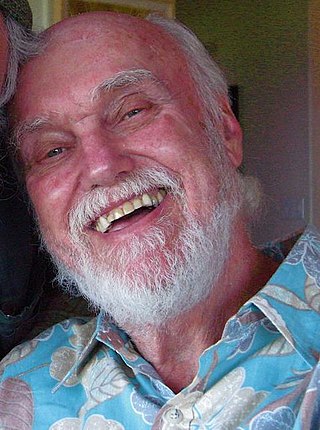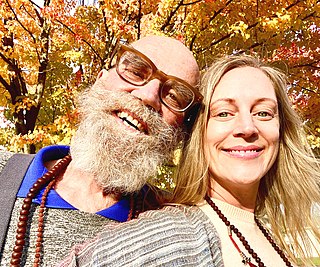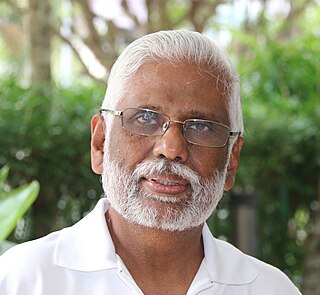
Ram Dass, also known as Baba Ram Dass, was an American spiritual teacher, guru of modern yoga, psychologist, and writer. His best-selling 1971 book Be Here Now, which has been described by multiple reviewers as "seminal", helped popularize Eastern spirituality and yoga in the West. He authored or co-authored twelve more books on spirituality over the next four decades, including Grist for the Mill (1977), How Can I Help? (1985), and Polishing the Mirror (2013).

Neem Karoli Baba or Neeb Karori Baba, also known to his followers as 'Maharaj-ji', was a Hindu guru and a devotee of the Hindu deity Hanuman. He is known outside India for being the spiritual master of a number of Americans who travelled to India in the 1960s and 70s, the most well-known being the spiritual teachers Ram Dass and Bhagavan Das, and the musicians Krishna Das and Jai Uttal.

Krishna Das is an American vocalist known for his performances of Hindu devotional music known as kirtan. He has released seventeen albums since 1996. He performed at the 2013 Grammy Awards, where his album Live Ananda (2012) was nominated for the 2013 Grammy Award for Best New Age Album. He's been described by the New York Times as "the chant master of American yoga".

Ralph Metzner was a German-born American psychologist, writer and researcher, who participated in psychedelic research at Harvard University in the early 1960s with Timothy Leary and Richard Alpert. Metzner was a psychotherapist, and Professor Emeritus of psychology at the California Institute of Integral Studies in San Francisco, where he was formerly the Academic Dean and Academic Vice-president.

Surya Das is an American lama in the Tibetan Buddhist tradition. He is a poet, chantmaster, spiritual activist, author of many popular works on Buddhism, meditation teacher and spokesperson for Buddhism in the West. He has long been involved in charitable relief projects in the developing world and in interfaith dialogue.

Bhagavan Das is an American yogi who lived for six years in India, Nepal, and Sri Lanka. He is a bhakti yogi, kirtan singer, spiritual teacher and writer.

Baba Hari Dass was an Indian yoga master, silent monk, temple builder, and commentator of Indian scriptural traditions of dharma and moksha. He was classically trained in the Ashtanga of Patanjali, as well as Kriya yoga, Ayurveda, Samkhya, Tantra, Vedanta, and Sanskrit.

Lama Foundation is a spiritual community founded in 1967, located in the Sangre de Cristo Mountains of northern New Mexico, seventeen miles north of Taos. The original commune was co-founded by Barbara Durkee, Stephen Durkee, and Jonathan Altman.

League for Spiritual Discovery (LSD) was a spiritual organization inspired by the works of Timothy Leary, and strove for legal use of lysergic acid diethylamide (LSD) for the purpose of meditation, insight, and spiritual understanding. It was in existence during the mid-to-late 1960s, and eventually closed by Leary. The New York Center for the League of Spiritual Discovery, in existence for around a year, was co-founded by Timothy Leary and Nina Graboi in 1966. The center was the first LSD-based meditation center in Manhattan.
"Be Here Now" is a song by English rock musician George Harrison from his 1973 album Living in the Material World. The recording features a sparse musical arrangement and recalls Harrison's work with the Beatles during 1966–1968, through its Indian-inspired mood and use of sitar drone. Part of Harrison's inspiration for the song was the popular 1971 book Be Here Now by spiritual teacher Ram Dass – specifically, a story discussing the author's change in identity from a Western academic to a guru in the Hindu faith. Some Harrison biographers interpret "Be Here Now" as a comment from him on the public's nostalgia for the past following the Beatles' break-up.
Sudhir Mukerjee, better known as Dada Mukerjee, was an Indian writer who was professor of Economics at Allahabad University, Uttar Pradesh, India. He is best known as a close devotee of Neem Karoli Baba. Starting 14 July 1958, when they moved into the "Red House" at No. 4 Church Lane, Baba Neem Karoli resided with Mukerjee and his wife Kamala during the winters. This continued until Baba Neem Karoli's Mahasamadhi in 1973.
Stephen Levine was an American poet, author and teacher best known for his work on death and dying. He is one of a generation of pioneering teachers who, along with Jack Kornfield, Joseph Goldstein and Sharon Salzberg, have made the teachings of Theravada Buddhism more widely available to students in the West. Like the writings of his colleague and close friend, Ram Dass, Stephen's work is also flavoured by the devotional practices and teachings of the Hindu Guru Neem Karoli Baba. This aspect of his teaching may be considered one way in which his work differs from that of the more purely Buddhist oriented teachers named above. Allusions in his teachings to a creator, which he variously terms God, The Beloved, The One and 'Uugghh', further distinguish his work from that of other contemporary Buddhist writers.

Abdullah Nooruddeen Durkee was a Muslim scholar, thinker, author, translator, and the Khalifah (successor) for North America of the Shadhdhuli School for Tranquility of Being and the Illumination of Hearts, Green Mountain Branch. Nooruddeen Durkee became a Muslim in his early thirties in Al-Quds, Jerusalem. He was one of the co-founders of Lama Foundation and founder of Dar al-Islam Foundation.

Omega Institute for Holistic Studies is a non-profit educational retreat center located in Rhinebeck, New York. Founded in 1977 by Elizabeth Lesser and Stephan Rechtschaffen, inspired by Sufi mystic, Pir Vilayat Inayat Khan and his ecumenical spirituality, today it offers classes to over 25,000 people a year, at the 190-acre (0.77 km2) campus.

Fountain of Light was a hippie underground newspaper of the 1960s published monthly in tabloid format in Taos, New Mexico, from 1969 to 1970. At least 14 issues were published before the paper went under in June 1970.
Aghor Yoga is a spiritual tradition that originated in Northern India around the 11th Century C.E. The word Aghor literally means "that which is not difficult or terrible"; according to its adherents, Aghor is a simple and natural state of consciousness, in which there is no experience of fear, hatred, disgust or discrimination. Accordingly, believers contend that any time that humans experience a state of discrimination, we limit our wholeness and fall prey to disruptive emotions such as anger, fear, jealousy, greed, and lust. The practices of Aghor Yoga today reflect reforms made in the 1960s, shifting the focus of Aghor to seeking a balanced life of selfless service and personal practice. Baba Bhagwan Ramji encouraged the practitioners of Aghor to follow the vamachara by embracing socially stigmatized and neglected people, such as street children and people with leprosy and other "untouchable" diseases. Today, the followers of Aghoreshwar Bhagwan Ramji have established a large network of schools, orphanages, medical clinics, or other social service projects.
Baba Rampuri, born William A. Gans, also known as Baba Ram Puri -ji is an American born Sadhu. He claims to be the first westerner to become a Naga Sadhu, having been initiated in 1970. He is the author of the 2010 Destiny Books published book Autobiography of a Sadhu: A Journey into Mystic India, originally published in 2005 by Harmony/Bell Tower as Baba: Autobiography of a Blue-Eyed Yogi, and now released by Amarpuri Wellness in 2016 as Autobiography of a Sadhu: An Angrez among Naga Babas which has also been translated into German, Russian, Czech, Croatian, and Serbian. He was initiated into the religious order the Naga Sannyasis after traveling to India on a spiritual quest from his native California in 1969, at the age of 18. Like many Sadhus, he has stopped using his birth name since his initiation, refuses to give it, and is unwilling to talk about his past. He is Shri Mahant at Shri Panch Dashnam Juna Akhara.

Baskaran Pillai, also known as Dattatreya Siva Baba or Siva Baba, is an authentic representative of the Tamil Siddha tradition and one of the first of its lineage to promote knowledge of the Tamil Siddhas in the West. Wayne Dyer endorsed and popularized Dr. Pillai's manifestation teachings through his book Manifest your Destiny, which he dedicated to Pillai and also wrote a chapter in his final book I can See Clearly Now. The Tamil Siddhar are spiritual technologists who practiced metaphysical arts and sciences. Time magazine called Pillai "The YouTube Guru". He has initiated philanthropic projects across India, Mexico and the U.S., which include the Million Meals Project and educating underprivileged children. His educational programs in public schools and tuition centers focuses on developing academic and social skills of disadvantaged students in India, Mexico and the United States through brain-enhancement sounds. These programs are implemented through the Tripura Foundation, established by Pillai in 1991, a consulting non-governmental organization to the United Nations Economic and Social Council (ECOSOC).

Ruth Horsting, also known as Ma Renu was an American sculptor, professor, author, community organizer, philanthropist, and a student of Ashtanga Yoga. She is known for her bronze and steel sculptures, and taught at the University of California, Davis from 1959 to 1971. Horsting was the first female sculptor hired in the entire University of California system.














